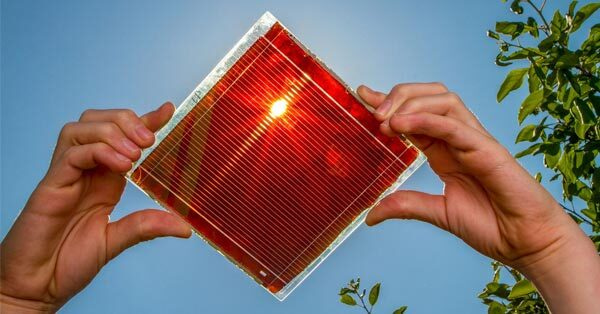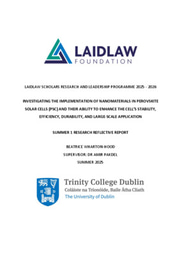Project Outline: Investigating the implementation of nanomaterials in perovskite solar cells and their ability to enhance the cell’s stability, efficiency, durability and large-scale application

Solar energy systems, particularly photovoltaic cells, play a pivotal role in renewable energy production across the globe. Had it not been for the Bell laboratories and their initial development of solar cells in 1954, the world of solar energy and its widespread impact would paint a very different picture (Kim et al., 2016). As a result of continuous research and development, the solar photovoltaic cell has been able to improve in terms of efficiency, accessibility, and applicability across the globe. This industry is expected to produce 8 255 TWh of electricity globally by 2030, making it the third biggest generator of renewable energy (IEA, 2023). Not only does this highlight the technology’s bright future, but it also clearly shows the necessity to continue to enhance its performance from power-energy conversion, lifespan, and large-scale manufacturing perspectives.
Recent developments of new photovoltaic materials and designs show promising signs of increased efficiency and power generation. In particular, the discovery of Perovskite Solar Cells (PSC) in 2009 has created an influential stepping stone in increasing the power-energy threshold, as well as allowing the panels to be used in scenarios requiring flexibility and movement (Wang et al., 2022). Perovskite compounds, which are typically consist of combination of ions, metals and halogens in a chemical structure, have shown to generate over 26% power-energy conversion rates (Solar Energy Technologies Office, 2018). However, issues such as the stability of the compound over long-term usage and varying environmental conditions, and degradation of the compound have limited its usage in large-scale applications (Djurišić et al., 2017).
Research has been conducted into the various ways these issues can be resolved in PSCs. One potential way of increasing the durability and the efficiency of this cell is through the inclusion of nanomaterials in the cell’s structure. Nano-materials, which are materials consisting of particles at the nanoscale (Findik, 2021), possess desired properties for solar cell applications, such as high conductivity and high surface-to-volume ratio (Deshmukh et al., 2021). These properties not only provide the opportunity to enhance the power generation of the cells but also show the ability to address the significant issues of stability and durability. By solving these concerns, this can enable the production of PSCs to notably evolve and be utilised around the world.
Aims and objectives
This project aims to:
- Identify which current nanomaterials are being utilised in PSCs;
- Further understand how these nanomaterials being implemented in the design of PSCs;
- Evaluate their performance regarding the improvement of stability, durability and efficiency of the cell during its lifetime;
- Analyse the manufacturing methods used to integrate these materials into the cells;
- Assess the accessibility of these manufacturing processes to solar-cell manufacturers across the globe.
It is through these aims that the following objectives and goals can be achieved:
- Create an accessible and understandable evaluation of these materials and their uses in PSCs;
- Identify which nanomaterial outperforms its counterparts in improving PSCs performance from a stability, durability, and efficiency perspective;
- Recognise any issues and/or unintended consequences of the material’s usage in the cell;
- Perform a thorough investigation of the manufacturing methods utilised and understand their economic and environmental impacts;
- Identify any emerging/potential nanomaterials that could be utilised in PSCs using further research;
- Deliver a rationale and substantial conclusion on the use of nanomaterials in PSCs and their future in the advancement of solar photovoltaic technology.
It is through these aims and objectives that improved understanding regarding the implementation on nanomaterials in PSCs and the solar energy industry can be achieved. By identifying and discussing these findings, it is hoped that solar photovoltaics can extend their positive impact on the world of renewable energy, and the fight against climate change. The more advanced and effective the cells become at converting solar energy into electrical energy, the more opportunities the solar energy industry has to be used across the world, across various applications and industries, and within our day-to-day lives.
Project plan and outline
|
Week number |
Research agenda |
Objectives |
|
1 |
Identifying key nanomaterials currently being used in PSCs, as well as developing materials
Identify purpose for which the materials are being utilised in the cell |
Narrow focus of research to 3 key nanomaterials being utilised in these cells based on current usage
|
|
2 |
Collection of data and findings regarding the key characteristics (material properties and behaviours) of the nanomaterials, and their contributions to the stability, durability and efficiency of the cell |
Identifying and comparing nanomaterials and their ability to enhance PSC cell performance |
|
3 |
Analysis of quantitative and qualitative data found in Weeks 1 and 2
Representation of findings using numerical and statistical formats |
|
|
4 |
Collection and evaluation of manufacturing processes associated with nanomaterial usage |
Identifying areas of opportunity for implementation of nanomaterials in PSCs
Analyse and address environmental/economic consequences of process |
|
5 |
Analyse and report findings |
|
|
6 |
Analyse and report findings |
|
My passion for renewable energy and the environment is what led me to studying engineering. Growing up in South Africa, which is sometimes referred to as “sunshine nation” because of our extensive solar exposure, solar energy and its various technologies are something I grew up learning about, and understanding how it has the capability of revolutionising energy systems. I have always found the renewable energy industry fascinating as it is the perfect match of developing and understanding cutting-edge technology, whilst solving pressing issues such as climate change and global electricity accessibility. This research question will enable me to further educate myself on the world of renewable energy but also leap into a new world of infinite knowledge and applications: Nanomaterials and nano-engineering. This field is an extremely exciting sector of engineering as its usage in industries such as medicine, renewable energy and the automative industry has already enabled revolutionary discoveries. I strongly believe that through this project and its findings, I will be able to positively display and substantiate the power that nanomaterials have to strengthen the solar photovoltaic industry.



Please sign in
If you are a registered user on Laidlaw Scholars Network, please sign in